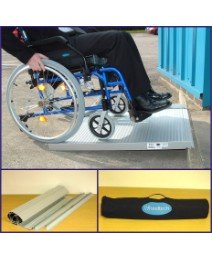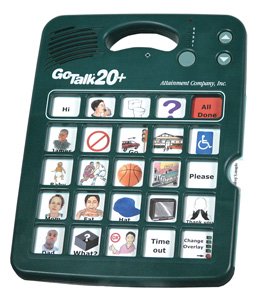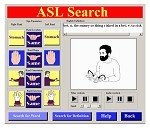Wheelchair Ramps Guide
Portable Handicap Ramp Options
At some point, you're likely to need wheelchair ramps if you're use a wheelchair or scooter. One thing you soon discover is that the world is not so easy to inhabit anymore. Getting in and out of your own home is probably the first thing you'll have to contend with, and adding a permanent wheelchair ramp, stair lift or elevator may be the way you decide to go.
I've pulled together some information that explains each of the different types of wheelchair ramps available, along with a good selection of ramps from our affiliate merchant partners. Keep reading below for information on Portable Wheelchair Ramp types: Threshold Ramps, Suitcase Ramps, Rollup Ramps, Telescoping Ramps, and advice on How to Choose Wheelchair Ramps.
However, as soon as you leave your home, you're likely to be run into problems again. If you have a scooter, or motorized wheelchair, or any type of self-propelled wheelchair, a street curb or threshold can literally stop you in your tracks.
So what to do?
Luckily, others have come up with the idea of portable ramps, and these mobility products can literally take the edge off of many encounters.
There are basically four types of portable wheelchair ramps available. Even with a permanent structure in place, it's quite likely that you'll also need one of the other portable types of ramps available - threshold, suitcase, rollup and telescoping.
Here's some information to help guide your decision....
Threshold Ramps
The simplest, and probably most commonly used, is the threshold wheelchair ramp.
It's a simple wedge shaped design that allows a wheelchair or scooter to enter a building by providing a mini-ramp for access.
This type of ramp will allow wheelchair or scooter door access from a height of about 1 inch to just over 6 inches.
The ramps are typically made of rubber or metal, and are usually 34 inches wide to accommodate most door widths.
Though typically stationary, most of these types of ramps are quite portable.
If you are considering a threshold ramp, consider the area just in front of the doorway as well.
Leave lots of room to stop and maneuver the wheelchair or scooter between the bottom of the ramp and any stairs.
Suitcase Ramps
A suitcase wheelchair ramp gets its name from the way that it's stored and carried. And, just like a suitcase, they are extremely easy to use, though perhaps a struggle to carry.
When open, this wheelchair ramp provides a solid surface that can be applied over stairs or to bridge a gap from the ground to a van.
The ramp can then be folded up (usually with only one fold along its length) and easily moved or stored.
This type of handicap ramp comes in lengths of 2 feet to 8 feet and can be used to bridge the gap over curbs, steps or raised landings, as well as van entry.
They are suitable for all types of wheelchairs and scooters, however be sure to check the maximum weight ratings.
Rollup Ramps
A newer type of wheelchair ramp is a rollup ramp. This type of wheelchair ramp was designed for portability.
With this type of ramp, the central ramp area is stored as a rolled up cylinder. When ready for use, you just roll out the central track and attach the side rails to create a rigid surface.
The side rails act as a bumper guide, and add strength to the ramp area.
When the ramp is no longer needed, you just remove side rails and roll-up the middle ramp section.
This type of ramp, made of lightweight aluminum, comes in a nylon bag for easy transport.
As you can see by the image, they originally were really designed to help you with small inclines. However, as technology has improved, you can now find roll-up ramps that are actually quite long, while remaining sturdy.
My guess is that this style of ramp will become the first choice for portable wheelchair ramps.
Telescoping Ramps
This type of ramp is the simplest in design, and perhaps the easiest to transport.
It consists of two thin ramps that are strategically placed to provide a ramp for each side of the wheelchair.
A telescoping ramp is adjustable up to five feet in length, and locks into place with snap buttons.
The tracks are U-shaped for added safety.
A telescoping ramp usually come in 3 sections that link together, which makes it easy to carry and store.
The ramp is usually stored in a bag, that can hang over wheelchair handles.
Ease of use will really be determined by the level of incline, and work best when the incline is not too steep.
These are best used when a second person is controlling the wheelchair on the ramp.
How to choose Wheelchair Ramps
With all type of wheelchair ramps, it's important to check both the weight specifications to make sure that it will handle the weight for both you and your wheelchair or scooter.
Also, ensure that the length and height of the ramp are suitable for your your particular situation. It may well be that you'll want more than one handicap ramp to meet different needs. Being able to make a doorway accessible, or providing curb access on your property may well require semi-permanent placement of one of these ramps.
However, portability and ease of access may be more of an issue for when you are in the community. For instance, will you have assistance to obtain your ramp and place it where it's needed? What weight and size configuration is easiest for your assistant to handle?
Do you need to also use the portable ramp for access to your van? Which ramp is best suited for that purpose? It may not be the same type of ramp best suited for other purposes, so you may want to budget for a separate ramp for that purpose.
Remember that not all ramps are designed for scooters, so be sure to take that into consideration as well.
Lastly, consider what type of portable ramp is most appropriate for where and how you will be storing and transporting your ramp so that it will be ready for use when you need it. Consider both home / indoor storage as well as portable storage needs. Will the handicap ramp you choose fit well in your vehicle or storage area? Will it be easy to store at your destination, or carry it with you as needed?
Making the right decision in your choices of ramps will have an impact on your ability to comfortably travel and interact in your community, so take the time to choose the right mobility products for you.
Comments are moderated - by a human who also lives offline.
Please allow up to 48 hours before comments are displayed.
Sign up for our FREE Newsletter
Sign up for our FREE
Special Need Products Newsletter
Sign up now to get updates and special offers in our occasional newsletter.
Don't worry, your e-mail address is totally secure.
I promise to use it only to send you the
Special Needs Products Newsletter.
Need something from our closed stores?
Contact us to let us know what you need.
|
I've worked with Anna on several purchases, some quite grandiose in terms of scale, and I can easily say that not only was Anna incredibly helpful, but the depth and breadth of knowledge and professionalism she imparts is bar none when it comes to special needs. Frank, |
|
Thank you for great customer support! Mary Vono, Social Worker, Sunshine Haven, Whitinsville, MA |
|
Wow, I am so impressed with your site, and all your products... finally!! All I have been searching for... I thank God for your site and products you carry -- all the products I have been struggling to get for my 12 yr old daughter in every subject you cover. Thank you! Espy Miramontes, San Jose, California |
|
"It is good to see people still care to take care of customers with the upmost attention and service." Madeline |
|
" I wanted to let you know that I got the bracelets and they look great.." Jennifer |
|
Product: Deborah Squires, Dorchester, Ontario |
|
Product: |
|
These pajamas have changed our lives! My special needs daughter turns 13 years old this month and now wakes up with uncompromised pull-ups. The back zip pj's also cut down on her skin picking. ..This clothing is so well made and works so well that I think you should look into Seeing if medical insurance would cover it. Jennifer Johnson, Arkansas |
|
Product: |
|
Product: |
|
Product: |
|
Thank you very much Anna! You've gone above and beyond and been so very human through our entire transaction. I appreciate all you've done. Julie Smith-Allen, Blairmore, Alberta |







